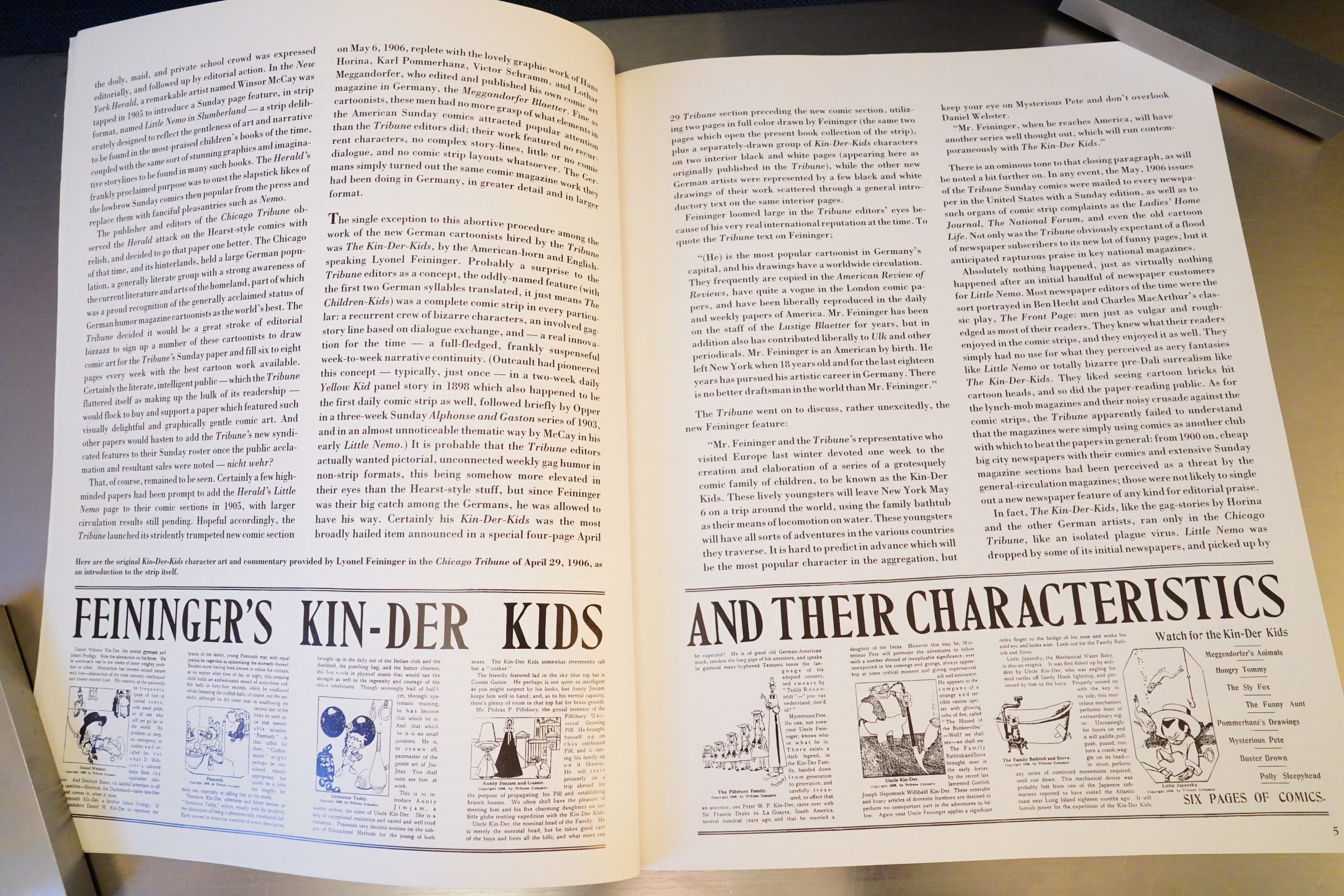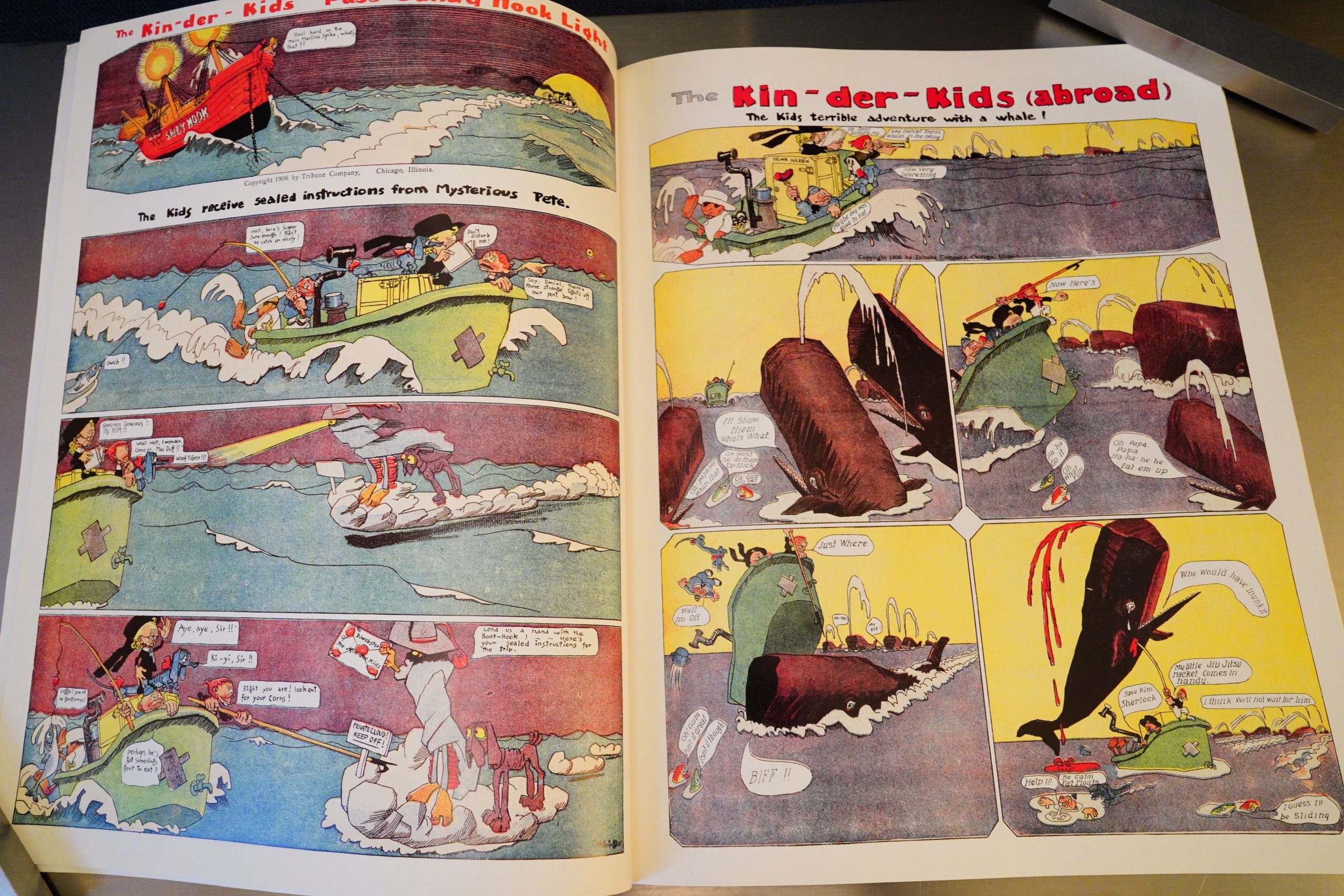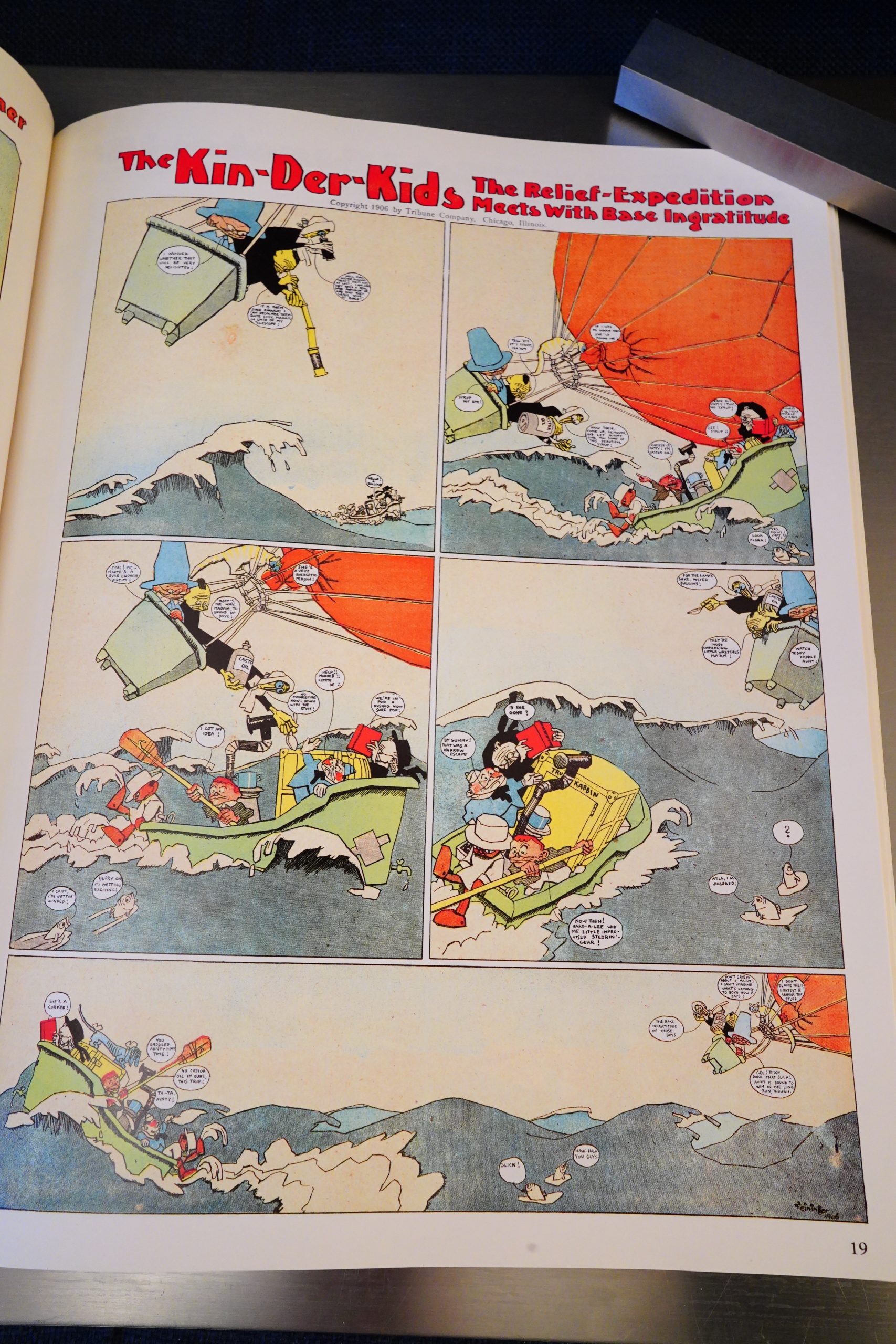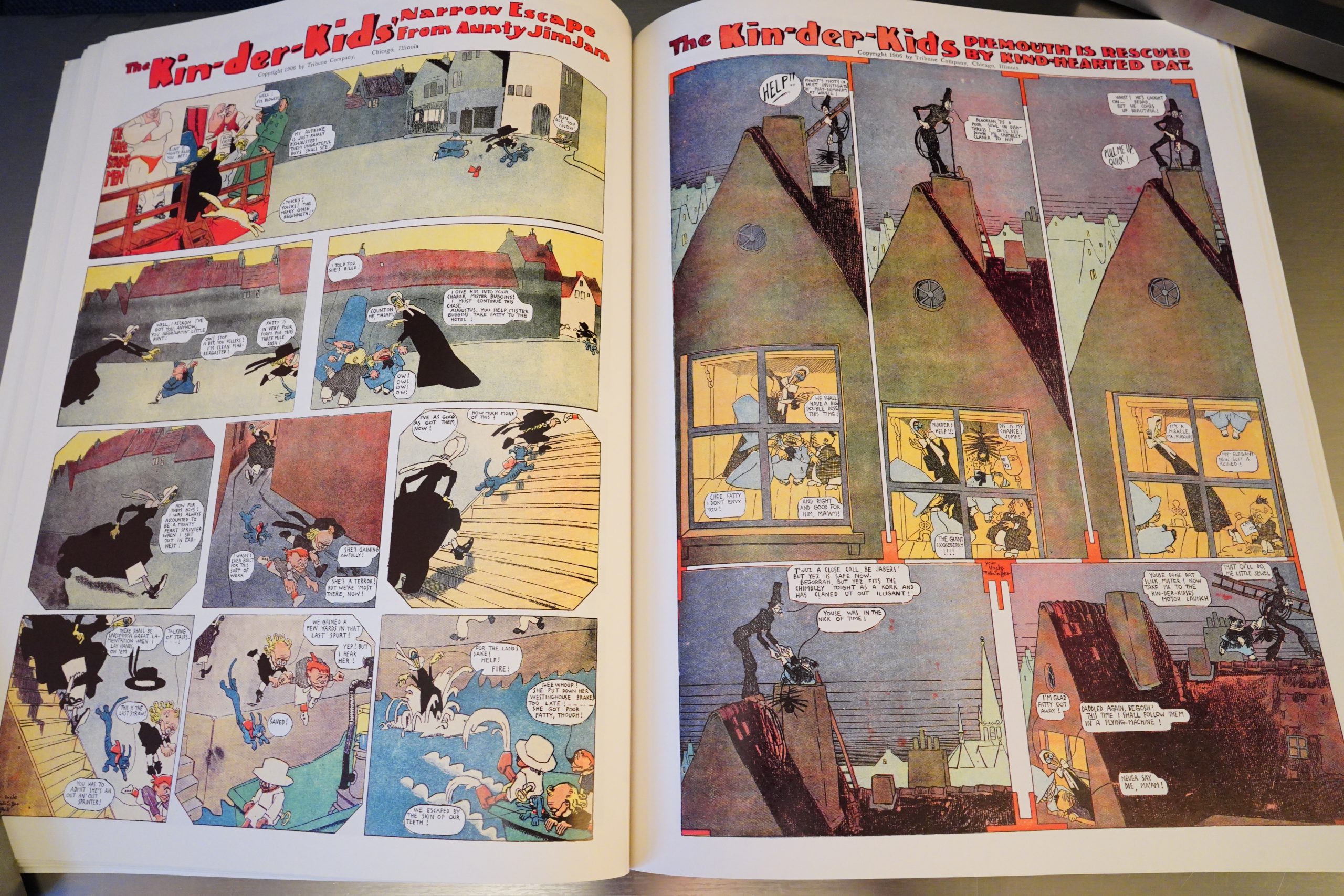The Comic Strip Art of Lyonel Feininger (1994) by Lyonel Feininger
This is a quite large book — not quite Raw size, but almost — and apparently reprints all of Feininger’s comics, i.e., Kin-der-Kids and Wee Willie Winkie’s World, both from 1906. We get a pretty short introduction by Bill Blackbeard, presumably because of size constraints: A book of this size was probably not very cheap to produce. (On the other hand, Kitchen Sink still had (some) Tundra money to squander at this point, I think…)
And… yowza. The artwork here is amazeballs. Not static at all, as some comics from this era had a tendency to be.
And it’s all one long narrative, which is an odd choice for a weekly strip. But I mean, there’s not really much to the narrative: Some guys take a trip (to get away from the family or something), and it’s basically one long chase scene.
While the artwork is really amazing, and the storytelling is prescient, the story itself isn’t that gripping, and the jokes mostly fall flat. He’s got a constant patter going on, but the jokes mostly are just… there. We’re not talking Krazy Kat.
And even at this size, it’s reproduced too small. The lettering gets uncomfortably small to read (at least for these tired eyes).
But I mean… it’s endlessly graphically inventive.
So it was cancelled pretty quickly. I assume that all of this was an attempt to class up the comics pages with some real culture or something?
The Wee Willie stuff is even less amusing to read, but it’s got its charms.
It’s a beautiful book, with the gorgeous colours reproduced very well. But as a read, it leaves something to be desired, in my Philistine opinion.
Robert Boyd writes in The Comics Journal #178, page 63:
The Comic Strip Art of Lyonel Feininger is a
book no serious scholar Of the comic strip form
should be without. Lyonel Feininger’s entire
American comic strip output is handsomely
reprinted in this oversized book, along with an
interesting (though flawed) introduction by Bill
Blackbeard. Reading The Kin-Der-Kids and
Wee Willie Winkie’s World will undoubtedly
cause many readers to experience a sense of
regret that Feininger did so little, and that the
comic strip wasn’t his life’s work. This is an
understandable reaction, but wrong. lfFeininger
had continued to be a professional cartoonist,
he would never have developed into a painter,
and his paintings are far more important artistic
works than his comics. His oeuvre as a painter
has fundamentally greater significance and
power than his comics and cartoons.
Blackbeard touches on Feininger’s career
as a painter briefly in his essay, but in a surpris-
ingly dismissive way. Feininger earned his bread
as a cartoonist for about twenty years, and
during part of that period, he was Germany’s
most successful political cartoonist. If he had
died before drawing The Kin-Der-Kids, he
would still be assured a relatively prominent
place in the history of cartoons. The Kin-Der•
Kids and Wee Willie Winkie’s World simply
form an astonishing climax to an already distin-
guished career. And yet, he gave all this up for
painting. And it was not painting in a commer-
cially viable style; Feininger threw his lot in
with the avant garde at a time when no modern-
ist painter could hope to make a reasonable
living for himself. Feininger was not indepen-
dently wealthy, and had a wife and children to
support, yet he still gave up a lucrative career
for a very speculative one. Why? This is a
fundamental question which Blackbeard fails
to address in his introduction. (The other major
question about The Kin-Der-Kids strip is an-
swered in Blackbeard ‘ s introduction — namely,
why did The Chicago Tribune publish such a
bizarre strip in the first place?)[…]
Feininger moved to Paris in
1906 to become a painter. He
studied with Matisse and ran in
the most advanced artistic
circles. But this kind of paint-
ing couldn’t support himself
and his wife, so he continued to
do cartoons for money. This
was when he drew The Kin-
Der-Kids and Wee Willie
Winkie’s World, as well as a
series of brilliant cartoons for
the Parisian journal Le Témoin.
(A very interesting companion
volume to The Comic Strip Art
ofLyonel Feininger would be a
collection of Feininger’s Le
Témoin cartoons and a selec-
tion Ofthe best Of his earlier cartoons.) Feininger
considered this work a horrible compromise he
made in order to earn enough money to live.
And yet, when we see these eartoons and comic
strips now, it is clear that they surpass every-
thing he had done before. It was here that
Feininger went from being a very good cartoon-
ist of a particular school, to being a great car-
toonist and a unique talent in the history of
cartooning.
Feininger created a comic language that
was his alone. I’ve already mentioned the “big
hands” aspect Of his drawing. Feininger devel-
oped ways of showing humans in motion with-
out motion lines — as shown by the wrestlers
and soccer players in The Kin-Der-Kids. The
large, flat, uninflected areas of color (as in
Cousin Gussie’s blue hat and coat) are ways of
depicting figures and objects that no one else
ever imitated.
In some ways, Wee Willie Winkie’s World
was even more radical. You won’t see clouds
like those on page 40 until Mattotti enters the
scene 80 years later. Likewise, virtually no one
has ever carried anthropomorphism to quite the
degree that Feininger did in this comic strip
(one thinks of a few early, weird Disney car-
toons and some of Kim Deitch’s work). Natu-
rally, Feininger’s obsessions from childhood
remain — the tall, narrow buildings (see the
chimney sweep page in The Kin-Der-Kids), the
big black steam locomotives throughout.
One wonders what would have happened if
Feiningerremained a cartoonist. He might have
spawned a new stream in American comic art.
Although there are certainly exceptions, it seems
to me that virtually every American comic strip
and comic book falls broadly into one of four
stylistic spheres. The earliest (and strongest) is
the scratchy style associated with Barney
Google, The Gumps, Mutt and Jeff, and Krazy
Kat. Then came a realistic illustrational style
associated with the work of Hal Foster and Alex
Raymond. The clean, brush-work oriented style
ofDisney is one important stream (with Pogo as
its highest achievement), and finally the mod-
ern minimalist style that Peanuts pioneered.
Feininger’s work clearly is outside Of all
these currents. However, if Feininger had man-
aged tocontinuedrawing American comic strips,
I suspect he would have ended up like Winsor
McCay — producing a body of work recog-
nized for its brilliance but essentially
uninfluential.
But Feininger left cartooning behind for the
very good reason that cartooning and comics
were inadequate forums for his art. For most Of
their history , comics have been industrial enter-
tainments tied up with the circulation-building
needs Of newspaper magnates and comic book
publishers, for whom comics were nothing more
than a way to sell papers. Anything that would
interfere with selling papers — drawing com-
ics with Strong personal content and high artis-
tic aspirations, without censorship — was not
only discouraged, it was unthinkable. The same
goes for comic books.
This is no longer the case. This changed in
1967 when Don Donahue published Robert
Crumb’s Zap #1. (Similar changes were hap-
pening with other “industrial” arts at the time,
such as movies —the decline of the studio
system — and pop music.) Now it is possible
for artists like Crumb, Lorenzo Mattotti,D Ian
Horrocks, ChesterBrown, or Jason Lutes
to produce comics that are equal in intent
and accomplishment to the paint-
ings Feininger produced. Perhaps
if Feininger had been born 100
years later, he would have never felt
the need to give up comics
for painting.
Well…
Richard Marshall writes in The Comics Journal #63, page 98:
Feininger remains an enigmatic
figure in comic strip history.
Working in an American art form for
an American audience, he was intro-
duced as a German. He had very few,
if any, conscious disciples (Harry
Grant Dart’s Explorigator, which
began in the New York World soon
after The Kin-Der-Kids’ demise ,
does seem to be a deliberate take-off.)
And strangest Of All, his superb ,
stunningly excellent weekly strip
lasted only seven months! A brief
visit, if one fraught with utter
mastery.
(Feininger did produce one other
comic strip, which ran concurrently
with the last few episodes of Kin—
Der-Kids and then succeeded it for
a brief period: Wee Willie Winkie’s
World. In my opinion, it was the
better strip of the two; it is a shame
that Dover declined to reprint this
short run—19 weeks ‘in all—for it
would have made this volume a
complete collection Of Feininger’s
strip work. It is unlikely that any
publisher will print a volume so slim
as to feature only the complete Wee
Willie Winkie’s World.)
Kin-Der-Kids was #40 in the Top 200 Comics of all time in The Comics Journal #210, page 68:
As a painter, Lyonel Feininger
would eventually gamer the aes-
thetic acclaim that in a better world
would already have been his as a
cartoonist. In each area of his cre-
ative endeavors, Feininger was
attuned to the preoccupations of
the fine arts of his day, so much so
that biographer and critic Hans Hess
noted that a single comic strip se-
quence “contains the problems of
modern art in a pure form” as well
as Feininger’ s own solutions tosame.
What will strike contempo-
rary readers of 1906’s The
Kin-der-K1ds is a stunning burst Of
pictorial imagination informed by
cultivated taste and executed with
distinct flair. Today we get caught
up by the colon and their bold
combinations, the clever construc-
tion ofpanel and page, the expressive
line work, the stylized design, the
purposeful exaggerations and dis-
tortions, and we need never be the
wiser for the international
artistic movements they re-
flected. Instead we are carried
away by the glorious full-
page Sunday funnies with
Feininger’s remarkable crew
of kid adventurers, dashing
across the globe in a bathtub,
chased by Auntie Jim-Jams
and her dreaded bottle Of
medicinal fish oil.
Despite its madcap na-
ture, the strip radiates a
gentleness and takes time to
revel in wonder (commis-
sioned, as it was, to serve as a
commercial foil for the furi-
ous rough-and-tumble ofthe
Hearst Rrnny pages). In that
better world, it would have
lasted more than 29 episodes.
This work has been reprinted later:
In 2011 Sunday Press Books published the book: Forgotten Fantasy: Sunday Comics 1900-1915, ISBN 978-0-97688-859-8, collecting the complete The Kin-der-Kids and the complete Wee Willie Winkie’s World.
This is the one hundred and seventy-second post in the Entire Kitchen Sink blog series.







